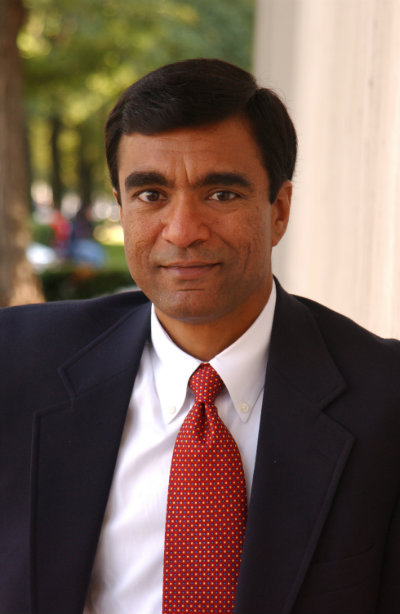
Research spotlight: Finance insights from the Trulaske College of Business

Faculty in the Robert J. Trulaske, Sr. College of Business Finance Department are always busy examining the issues relevant in today's world of finance. Recent research has shed light on the impact of patent litigation on stock returns, how the reputation of an auditor can impact the longer-term performance of post-IPO stock, the benefits of reverse mortgages and how publicizing the names of who manages mutual fund can impact the performance of those funds.
Hang on! Stock returns of patent litigators will likely increase down the road
Associate Professor Fred Bereskin
Let’s face it, most people recoil when they hear the words “patent infringement” and “litigation,” especially when used in the same sentence – and investors are no exception. Who wants to sink their money into or stay with a company embroiled in a lawsuit that involves the unlawful use, selling or copying of a patented invention or intellectual property?

But research from Fred Bereskin, associate professor of finance and Richard G. Miller Professor of Finance, found investing in an alleged patent infringer might just pay off.
Using patent lawsuit data from 2000 to 2014, Bereskin and fellow researchers Po-Hsuan Hsu, William Latham and Huijun Wang found a stock portfolio consisting of alleged patent infringers provided significantly higher stock returns – between .048% to .61% per month – in the following year than other firms with similar characteristics. In contrast, plaintiff firms’ subsequent stock returns were not significantly different from comparable firms’ returns.
“On the face of it, the results appear rather surprising,” Bereskin said. “But upon further investigation, it begins to make sense.”
Researchers examined several possible explanations for the outcome, including exposure to an unknown systemwide risk, cash holdings and financial constraints. But it was stock investors’ excessive pessimism about the infringement charges and fear of complex patent information that led them to over-discount stock prices – and thus, higher subsequent stock returns.
“Our results suggest that alleged infringers experience less industry competition and become more profitable in the three to five years following litigation,” Bereskin said. “These findings are consistent with prior studies arguing that patent infringement litigation highlights the barriers to entry associated with businesses – thus deterring potential competitors – and reflects the profits to be earned from alleged infringers’ use of plaintiffs’ intellectual property. So, in the beginning there is excessive pessimism, but eventually, there are positive outcomes for firms because there is less competition and increased profitability.”
Bereskin said investigating the outcomes of patent infringement and associated litigation is important because the number of such cases has increased dramatically since the 1980s. This uptick in litigation has also exposed firms to significant direct and indirect costs for patent lawsuits. According to the study, the median patent infringement suit incurs litigation costs ranging from $100,000 (when less than $1 million is at risk) to $5 million (when more than $25 million is at risk).”
Aside from these direct costs, there are indirect costs such as distraction to management and difficulties in ensuring long-run commitments with supplies and customers, as well as attracting financing and delays in implementing innovation and marketing strategies.
“Patent infringement litigation can be very hard on a firm’s long-run viability,” Bereskin said.
Bereskin’s paper, “So, Sue Me! The cross sections of stock returns related to patent infringement allegations” was published in the Journal of Banking and Finance.
Firms with reputable auditors show better long-term performance of post-IPO stock
Professor Sudip Datta
When a privately-held company offers shares to the public for the first time – a process called initial Public Offering or IPO – potential investors are looking for indications that the soon-to-be publicly-traded company is healthy and worth the backing.

One well-established clue is the strength of the underwriter involved in the process – the higher ranked the underwriter, the better post-IPO stocks perform. But a recent study by a team of researchers including Sudip Datta, chair of the Finance Department and professor of finance at the Robert J. Trulaske, Sr. College of Business, Mark Gruskin of Penn State University-Lehigh Valley, and Mai Iskandar-Datta of Wayne State University, found another indicator that has a more pronounced and persistent effect on post-IPO equity performance. That indicator is the quality of the auditor which is a phenomenon called the “auditor certification effect.”
“The study found that the reputation of the auditor has a significant impact on the long-run, post-IPO stock price performance, independent of the underwriter reputation,” Datta said. “Remarkably, past literature has not addressed the impact of the auditor’s reputation on the sustained stock performance. This void accentuates the novelty of our contribution and suggests that the role of auditor reputation may have even broader implications than previously realized.”
The findings also hold practical implications for firms considering going public, underscoring the importance of an auditor’s reputation in the IPO process and how that can impact the long-term value of the stock. Additionally, the study found that the choice of auditor is even more important when the reputation of the underwriter is lacking. Researchers also found that the impact on post-IPO stock return performance is even greater for high-growth firms.
According to the study: “The underwriter’s role is somewhat transient, peaking at the initial stages post-IPO, whereas the impact of the auditor is enduring and becomes more pronounced over time, reflecting the continuous firm-auditor relationship.”
Datta pointed out that an underwriter’s involvement is a “one-time deal. They help take the firm go public and that’s it. The auditor is a repeated game – every year there is an audit which has a much longer effect on the firm.”
Among the methods used in their study, researchers examined the long-run, post-IPO stock returns for IPO firms with prestigious (high-ranked) auditors and for those with less prestigious (low-ranked) auditors. They found that IPOs with low-ranked auditors had consistently negative returns over 12, 24 and 36 months. In contrast, IPOs with high-ranked auditors showed significantly better performance, especially at 24 and 36 months.
“The individuals who invest in these IPOs look for some third-party certification to help them determine the quality of the firms and how they will perform in the future,” Datta said. “So, we looked at auditor certification, which no one has looked at before, and we found a strong effect on how these company’s stocks perform after the IPO over a longer period.”
Datta’s paper, “Auditor certification and long-run performance of IPO stocks” was published in the Journal of Financial Stability.
The benefits of reverse mortgages reach beyond older homeowners
Assistant Professor Jialu Shen
Reverse mortgages can provide a lifeline for older homeowners on fixed incomes who want to continue living in their homes but need extra cash to pay for living expenses.
Like the name implies, these home loans work backwards. Rather than making payments to the bank, homeowners receive payments – like an advance on the eventual sale of the home. In general, eligible homeowners must be 62 or older and have paid at least 50% of their mortgage to apply. The money is tax-free.

While reverse mortgages sound like a reasonable solution for older homeowners, research from Jialu Shen, an assistant professor of finance, has found that the benefits of these loans don’t stop with the older recipients.
“Our research demonstrates that the inclusion of reverse mortgages also has a significant impact on housing prices,” Shen said. “As a result, the housing market becomes more competitive, making homeownership more appealing and stimulating demand for housing.”
Shen also found that older homeowners who opt for reverse mortgages experience enhanced “consumption smoothing” – or a balance between spending and saving – compared to those who do not participate.
“I think a big concern of a lot of retirees is, ‘Can I maintain the same quality of life that I had when I was working?’” she said. “Reverse mortgages give retirees a chance to do that.”
Shen said she has taken a special interest in the effects of reverse mortgages because there are a growing number of retirees whose pensions and Social Security aren’t enough to sustain them. She added that people are living longer and facing more socioeconomic disparities, adding to the need for options like reverse mortgages.
“We have to improve retirees’ welfare,” she said. “We are all part of society and we are all going to grow old. It’s important to look at opportunities like reverse mortgages.”
While homeowners who choose to get a reverse mortgage can continue to live in their homes, these loans must be repaid when the borrower dies, permanently moves out or sells the home.
“And if the selling price of the home is more than the loan, you get what is left over,” Shen said. “You or your surviving family members get to enjoy the benefits of that extra money.”
Shen, whose research team included Shize Li and Ariel Sun, used a quantitative equilibrium model with various types of households, competitive lenders and house prices with the presence of conventional mortgages and reverse mortgages. They modeled booms, recessions and crises with cyclical interest rates. The model also considered multiple sources of household risks, including health, longevity and interest rate risks, and uncertainty in housing prices and economic swings.
Shen acknowledged that reverse mortgages usually drive up housing prices, making it tough on renters who, in turn, must contend with higher rental costs. Still, the long-term impact of reverse mortgages is far-reaching.
“In an economy with reverse mortgages, young renters have the opportunity to aspire to become homeowners and utilize reverse mortgages as an additional avenue for accessing home equity,” she said. “Thus, even though they face some hurdles, renters still enjoy marginal benefits in an economy that incorporates reverse mortgages. However, as expected, older homeowners experience very notable welfare gains.”
Shen said that overall, an economy that includes reverse mortgages has universal benefits: “Encouraging older households to consider reverse mortgages carries multiple advantages, benefiting not only households themselves but also the broader society.”
Shen’s study, “Reverse Mortgages, Housing and Consumption: An Equilibrium Approach,” has been accepted for presentation at the American Real Estate Annual Conference 2024, the Royal Economic Society Meeting 2024, the 2nd Contemporary Issues in Financial Markets and Banking, an online conference hosted by the Nottingham Business School, China International Conference in Finance 2024 and the 2025 AREUEA-ASSA Annual Conference.
Know their names: Mutual funds with named managers outperform those kept anonymous
Assistant Professor Michael Young
People want to know their investments are in good hands. For most investors, that means access to financial information and answers to questions like “Who’s managing my money?”
So important is disclosure that in 2005, regulators in the United States mandated that agencies must disclose the names of individuals who manage mutual funds. The idea being that managers whose names are made public will have the same incentive to make money as their investors and thus, when the funds do well, everyone wins.
That hasn’t necessarily been the approach for other parts of the world despite the potential for agency conflicts, such as risk shifting, late trading and commission bundling to name a few. To address such agency conflicts, global regulators have often relied on disclosure.
Nonetheless, there remains variations internationally in naming mutual fund managers – a difference that is costing some investors.

According to an ongoing study by Michael Young, an assistant professor of finance, anonymously managed mutual funds significantly underperformed – by about 1% a year – when compared to funds whose managers were named. Using a global sample of mutual funds, researchers found that 17% of funds worldwide – excluding the U.S. – and 22% of emerging markets funds do not disclose the names of their management team. These anonymously managed funds were also found to be less active with some managers shirking their duties and doing little more than roughly tracking and indexing. In general, unnamed managers avoided competing or taking risks to improve their performance.
So, are anonymous managers less skilled than those whose names are made public?
“Not necessarily,” Young said. “The key is incentive.”
The study team, which included researchers from the Darden School of Business at the University of Virginia and the Nova School of Business and Economics, found that when kept anonymous, highly skilled managers under-performed because there was little incentive to do otherwise. Anonymity was being used as “bargaining power” over skilled managers because without ownership of their performance record, these managers had less ability to pursue outside employment.
However, when given the opportunity to be named, highly skilled managers had an incentive to rise to the occasion and performed well, becoming much more active and competitive among other managers.
According to the study, low skilled managers opted for anonymity to “pool” with higher-skilled managers and avoid recognition. Researchers discovered that revealing the names of low skilled managers did little to improve their performance or activity over time.
Young said that outside the U.S., where managers can remain anonymous, large banks often “trap” unwitting customers who, for convenience and safety, unwittingly put all their financial resources in one financial institution. The problem is this type of entrapment creates little incentive for anonymous managers to improve the performance of the bank funds.
“Those funds have historically been shown to not do very good because they have trapped investors,” he said. “It would be a hassle for customers to move their investments, so, these people don’t have a whole lot of power over where to go. What we find is those kinds of places are less likely to name their managers because they don’t have to. There is no incentive to name the managers.”
Young said his researcher team used the U.S. as a backdrop to their study because they were able to track the change in performance of mutual funds after the regulatory change in 2005.
Young’s study “Hiding in Plain Sight: The Global Implications of Manager Disclosure” has been presented at eight international conferences.